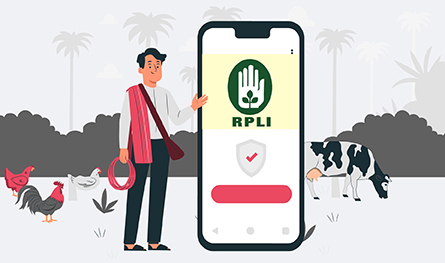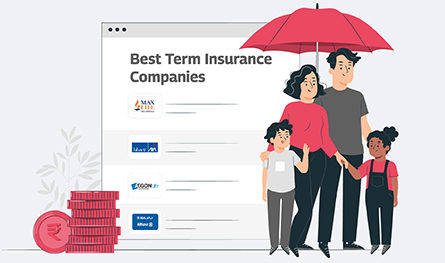6 Rural Postal Life Insurance (RPLI) Plans – RPLI Policy Features, Benefits and Plan Details 2025

RPLI or Rural Postal Life Insurance Plans are introduced with the primary objective of providing insurance coverage to the rural public. The plan aims to benefit the economically weak sections of the society and women workers in the rural areas. Learn more about the RPLI plan and its benefits in this post. Read on!

What is Rural Postal Life Insurance? – Know Everything About RPLI Policy and RPLI Full Form
RPLI stands for Rural Postal Life Insurance, RPLI are schemes planned for the people living in rural areas of India. As you know a majority of Indian population lives in the rural parts, and the RPLI scheme offers coverage to that enormous population at low premium rates, which can be seen in the RPLI premium table. The scheme targets the rural women and the weaker section of the society living in rural areas through the widespread network of post offices. The scheme aims at facilitating good health and financial security to the rural folks via RPLI policies.
The RPLI schemes were introduced based on the recommendations of the Malhotra committee, a special insurance committee that was created for enhancing reforms in the insurance sector in India in 1993.
1. Whole Life Assurance (Gram Suraksha Plan)
Objective of Whole Life Assurance (Gram Suraksha Plan): This RPLI policy aims to compensate the nominee of the policy with a sum that is equal to the assured sum together with offering accrued bonus amount to the nominee in case of sudden demise of the policy owner.
Eligibility Criteria for Whole Life Assurance (Gram Suraksha Plan): The plan permits 19 years as the minimum eligibility age, whereas 55 years as the maximum age of entry.
Policy Conversion: This policy can be changed to endowment plan once it completes 1 year. For this policyholder must convert the plan before completing the age of 57 years.
-
- Sum assured (Minimum): Rupees 10,000
- Sum Assured (Maximum): Rupees 5 lakhs
- Loan facility: Available after the policy completes 4 years.
- Surrender facility: Available after the policy completes 3 years.
- Premium to be Paid: Premium depend upon the amount assured as well as the applicant’s age.
- RPLI bonus rates: The plan offers bonus rate of Rs. 65 for sum assured of Rs.1000
2. Endowment Assurance (Gram Santosh Plan)
Objective of Endowment Assurance (Gram Santosh Plan): This scheme aims to fulfill the required needs of a policy owner. Even in this plan, the nominee receives an amount of the assured sum as well as the bonus accrued till the nominee reaches maturity age at the time of policyholder’s death.
Eligibility Criteria for Endowment Assurance (Gram Santosh Plan): The plan permits 19 years as the minimum eligibility age, whereas 55 years as the maximum age of entry.
-
- Sum assured (Minimum): Rupees 10,000
- Sum Assured (Maximum): Rupees 5 lakhs
- Loan facility: Available after the policy completes 3 years.
- Surrender facility: Available after the policy completes 3 years. Here, bonus gets nullified if the policy is surrendered.
- Premium to be Paid: Premiums depend on the amount assured as well as the applicant’s age. The applicant can make online premiums via online payment modes. Option for online mode also helps in RPLI policy status check online.
- RPLI bonus rates: The plan offers bonus rate of Rs. 50 for sum assured of Rs.1000
3. Convertible Whole Life Assurance (Gram Suvidha Plan)
Objective of Convertible Whole Life Assurance (Gram Suvidha Plan): The plan aims to compensate the nominee with an amount that is equal to the amount assured together with providing the accrued bonus in case of sudden demise of the owner of the policy.
Eligibility Criteria for Convertible Whole Life Assurance (Gram Suvidha Plan): The plan permits 19 years as the minimum eligibility age, whereas 55 years as the maximum age of entry.
Policy Conversion: This policy can be changed to an endowment plan once it completes 5 years. For this policyholder must convert the plan before completing the age of 55 years.
-
- Sum assured (Minimum): Rupees 10,000
- Sum Assured (Maximum): Rupees 10 lakhs
- Loan facility: Available after the policy completes 3 years.
- Surrender facility: Available after the policy completes 3 years. Here, bonus gets nullified if the policy is surrendered.
- Premium to be Paid: Premiums depend on the amount assured as well as the applicant’s age.
4. Anticipated Endowment Assurance (Gram Sumangal Plan)
Objective of Anticipated Endowment Assurance (Gram Sumangal Plan): Being a money-back plan, this policy serves the best interest of people who are looking for periodic cash for fulfilling the short-term monetary needs of the insured.
This policy is available in two different terms; one for a 15 years period and the other for 20 years period. The periodic payments in case of 15 year term is available in intervals of 6 yrs, 9 yrs, 12 yrs and 15 yrs. On the other hand, the 20 years term offer periodic payments in intervals of 8 yrs, 12 yrs, 16yrs and 20 yrs. However, in the event of the death of the policyholder, no periodic payments are made. However, here the nominee receives the entire sum assured and accrued bonus in one go.
Eligibility Criteria for Anticipated Endowment Assurance (Gram Sumangal Plan): The plan permits 19 years as the minimum eligibility age, whereas 45 years as the maximum age of entry for 15 years term plan, while it is 19 years minimum and 40 years maximum age for the 20 years term plan.
Policy Conversion: This policy can be changed to an endowment plan once it completes 5 years. For this policyholder must convert the plan before completing the age of 55 years.
-
- Sum assured (Minimum): Rupees 10,000
- Sum Assured (Maximum): Rupees 5 lakhs
- Surrender facility: Available after the policy completes 3 years. Here, bonus gets nullified if the policy is surrendered before 5 years.
- Premium to be Paid: Premiums depend on the amount assured as well as the applicant’s age.
5. 10 Year RPLI (Gram Priya Plan)
Objective of 10 Year RPLI (Gram Priya Plan): This is another short duration policy aimed at the rural customers to benefit the owner of the policy and their nominee with sum assured and accrued bonus on completion of the term of the policy.
Eligibility Criteria for 10 Year RPLI (Gram Priya Plan): The plan permits 20 years as the minimum eligibility age, whereas 45 years as the maximum age of entry.
-
- Sum assured (Minimum): Rupees 10,000
- Sum Assured (Maximum): Rupees 10 lakhs
- Surrender facility: Available after the policy completes 3 years.
- Premium to be Paid: Premiums depend on the sum assured as well as the applicant’s age.
Benefits of 10 Year RPLI (Gram Priya Plan):
-
- This plan offers 20% survival benefits after the policy turns 4 years, 7 years and 10 years, while 60% of the same is offered along with the accrued bonus.
- Here, interest is not levied on the policy holder for 1 year if there is any occurrence of natural calamities.
6. Children Policy (Bal Jeevan Bima)
Objective of Children Policy (Bal Jeevan Bima): This is a scheme that aims at offering life insurance protection to small children in rural India. Here, no amount is offered in the event of sudden demise of the policy owner/parent. However, the policyholder/child receives the entire assured sum together with the bonus accrued once the term matures.
Eligibility Criteria for Children Policy (Bal Jeevan Bima): The plan permits children within the age group of 5 to 20 years as eligible for the policy, while the age of the policy owner/parent should be 45 or below while buying the policy.
-
- Sum assured (Minimum): Rupees 1,00,000 (1lakh)
- Sum Assured (Maximum): Rupees 10 lakhs
- Surrender facility: Available after the policy completes 3 years.
Benefits of Rural Postal Life Insurance Plans
-
- These plans offer the benefit of deduction on premiums as per Section 80C of 1961 Income Tax Act.
- They also offer rebate to policyholders as per Section 88 of Income Tax Act.
- These policies can be revived if they get lapsed because of lapse in payment of premium.
- These policies can be used as guarantee for receiving credit/loan from any banks or financial institutions.
- These plans provide the facility of nomination, which can even be changed if required.
- The RPLI plans can be converted from one particular scheme to another. So the insured can move to another plan if he/she is not happy with the policy that the person owns.
Latest Statistics of Rural Postal Life Insurance (RPLI)
| Years | Policies in Force (Units) | Sum Assured (Rs. Crore) | Fund Corpus (Rs. Crore) |
| 2007-2008 | 61,67,928 | 41,846.09 | 3003.78 |
| 2008-2009 | 73,56,446 | 53,072.10 | 3994.36 |
| 2009-2010 | 99,25,103 | 59,572.59 | 5,524.69 |
| 2010-2011 | 1,22,03,345 | 66,132.23 | 6,607.79 |
| 2011-2012 | 1,35,47.355 | 69,754.17 | 9,141.43 |
| 2012-2013 | 1,46,64.650 | 75,154.06 | 11,388.20 |
| 2013-2014 | 1,50,14,314 | 79,466.46 | 13,352.01 |
| 2014-2015 | 2,35,14,055 | 1.05,204.79 | 14,968.67 |
| 2015-2016 | 1,49,15,652 | 81,733.73 | 18,113.78 |
| 2016-2017 | 1,46,84,096 | 83, 983.47 | 20,716.62 |

Author Bio
Paybima Team
Paybima is an Indian insurance aggregator on a mission to make insurance simple for people. Paybima is the Digital arm of the already established and trusted Mahindra Insurance Brokers Ltd., a reputed name in the insurance broking industry with 17 years of experience. Paybima promises you the easy-to-access online platform to buy insurance policies, and also extend their unrelented assistance with all your policy related queries and services.
Other Life Insurance Products
Latest Post
In a country where medical inflation is rising rapidly, securing a comprehensive health coverage plan for the entire family is no longer optional, it is essential. Selecting the right health insurance requires careful evaluation of multiple factors, not just premium costs. A well-chosen plan ensures financial security, access to quality healthcare, and peace of mind during medical emergencies.


Term insurance is an important investment. However, with the availability of so many insurers offering term plans, it becomes difficult to select the best term plan to suit your needs. Buying a term plan needs some consideration and research on the part of the policyholder. In this post, let us discuss the best term insurance providers in India.


Have you ever caught yourself lost in illusions about your daughter's future events, such as her university convocation and first day at work? Her university convocation. When she embarks upon her initial job after graduation will be the day.

.png)
When you sign up for a life insurance policy - whether it’s a traditional term insurance policy or a ULIP – you are not just buying peace of mind. You are also trusting the insurer with your money. So naturally, you would want to know: How is that money being managed? And more importantly, how is it being protected from risky decisions?

.png)
Globally, 20th October marks the day to observe World Osteoporosis Day. Do you know the significance of observing Osteoporosis on a global platform? Do you know how this condition affects people and their lives? Let us find out in this post!




